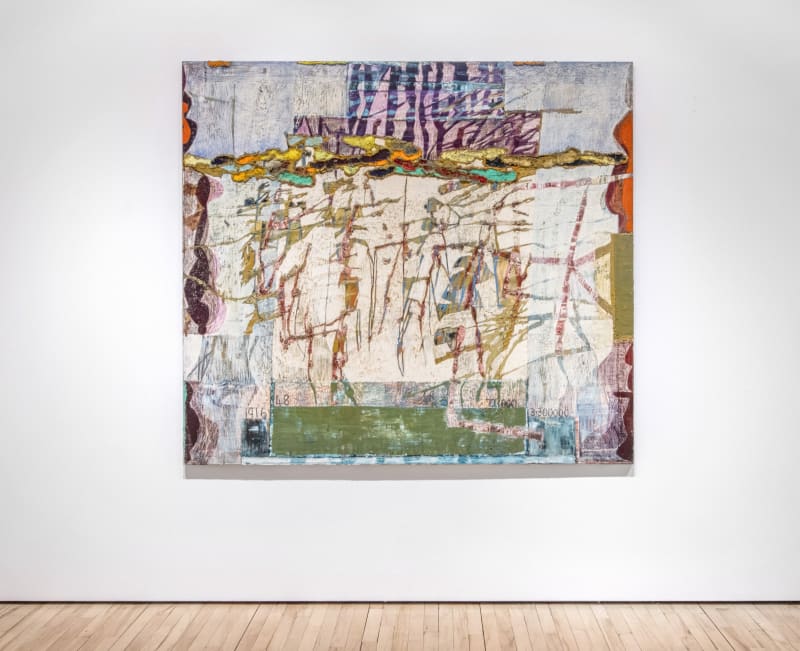Frestonian Gallery is delighted to present the first major solo show of Edmond Brooks-Beckman following his graduation from the Royal College of Art in the summer of 2023.
Brooks-Beckman’s paintings present as extraordinary palimpsests wherein the artist’s command of surface, colour and composition is frozen in a carefully determined moment between working, overworking and undoing. The seemingly shifting layers of dense oil paint are criss-crossed with lines, figures, half-formed words and half-familiar forms that shimmer and seek recognition amid the swirling mass of colour – both subtle and bold – and of positive and negative space.
This emerging, or perhaps exposure, of forms works in both directions (built ‘up’ and ‘down’) as Brooks-Beckman not only applies paint to the surface of the canvas, but also latterly excavates back into it, using a knife blade to painstakingly undo his own application, and in the process finding a halfway point between the end and the beginning – a halfway point that is itself the new, changed, complete surface. This applying and stripping, adding and subtracting, gives a clue to how Brooks-Beckman considers his own working process – a literal back-and-forth (or rather forth-and-back). The works themselves become rich and multifaceted through this winding path to the ‘end point’, with every painting bearing the marks, signs and scars of rigorous making and re-making.
The power and energy of symbolism in the work – whether overt or ambiguous – is a quality inherent in the work of some of Brooks-Beckman’s major influences. Artists such as Alan Davie, whose works evoked an almost diagammatic ‘mystic’ language, and Basil Beattie, who is cited as a key inspiration. Of a series of Beattie’s work the critic Mel Gooding wrote “Their mural-like dimensions and placement suggested that these paintings were, indeed, the writing on the wall, enigmatic glyphic conglomerations, the prophetic urtexts of Beattie’s expressive pictorial language”. In many ways Brooks-Beckman’s work may be ‘read’ in the same way – as an ever evolving pictural ‘language’ of his own making. The intent is not to inform or guide, however, but rather to provide the platform on which the artist can play out and explore the intensely personal mix of inputs into the language itself.
These inputs include the works of many dozens of other artists purely along the line of the tradition of painting itself – such as Gerhard Richter, Frank Auerbach, Egon Schiele (whose continuous and dynamic treatment of line was particularly revelatory) as well as a younger generation of painters such as Max Wade, whose 2019 exhibition at COB Gallery, London, Brooks-Beckman cites as turning point in the emboldening and transformation of his own style and process.
In this extraordinary body of work – created over two years up to September 2023 - Brooks-Beckman has brought into being a process, a language and a unique addition to the landscape of contemporary painting at a time when painting is again in prime position within the artistic discourse, and when the importance of the discursive vs the polemic is both continually challenged and thus ever more vital.
Notes on the artist:
Edmond Brooks-Beckman was born in 1987 in London, where he lives and works. He holds an MA in Painting from The Royal College of Art (2021-2023). His graduation show work 'Inscriptions beneath the skin, 2023' won the coveted Valerie Beston Prize. He has a BFA from Brighton University (2006-2009). His studio practice has always worked alongside his teaching practice. Having completed a PGCE at the IOE in 2016 and worked within secondary education as an Art and Design teacher he progressed on to foundation course leader at the Hampstead School of Art where he currently teaches.
Recent group exhibitions include ‘Tightrope’ by Subtitle Labs, (with Fungai Benhura, Suleman Khilji & Zearo), ‘Positions Part 2’ at Alma Pearl, London and ‘I Don’t Paint What I See’ at Berntson Bhattacharjee, London. His work will feature in a group show at Duarte Sequiera, Braga, Portugal in November 2023, as well as a solo presention at Duarte Sequiera Seoul, and with Frestonian Gallery in New York, both in 2024.
For further information on the exhibition and the artist please contact gallery@frestoniangallery.com

